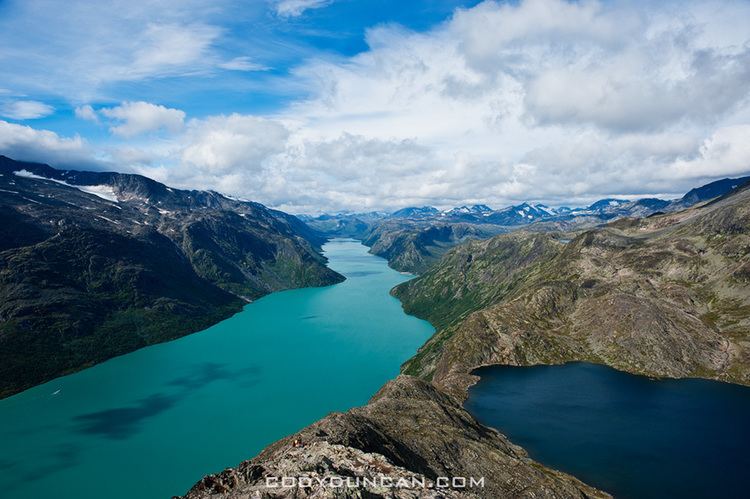 | ||
Similar Galdhøpiggen, Glittertind, Besshø, Trolltunga, Surtningssue | ||
Besseggen, or Besseggi, is a mountain ridge in Vågå kommune in Oppland county, Norway. Besseggen lies east in Jotunheimen, between the lakes Gjende and Bessvatnet.
Contents
- Map of Besseggen 2683 Tessanden Norway
- Impact of tourism
- Competitions
- Besseggen in the literature
- The name
- References
Map of Besseggen, 2683 Tessanden, Norway
The walk over Besseggen is one of the most popular mountain hikes in Norway. About 30,000 people walk this trip each year. The route over Besseggen starts at Gjendesheim, up to the trails highest point, Veslfjellet (1,743 m), down Besseggen, further over the relatively flat area Bandet (at the foot of Besshø), and ends at Memurubu, where one may take the regularly scheduled ferry route back to Gjendesheim. Many choose to do the hike in the other direction by starting at Memurubu after first taking the ferry there from Gjendesheim. The trip is estimated to take about 5–7 hours to walk without rest stops.
From Besseggen there is a great view over Gjende and Bessvatnet. One of the unique aspects of the view is that Gjende lies almost 400 m lower than Bessvatnet, and while Bessvatnet has a blue color typical of other lakes, Gjende has a distinct green color. The green color is the result from glacier runoff containing clay (rock flour). Looking down towards Memurubu one can see the nearby river Muru coloring the water with a light colored runoff.
Impact of tourism
The large number of hikers has led to serious erosion on the trails leading to Besseggen, both from Gjendesheim and Memurubu. In 2005 the Norwegian government authorized spending of 1.2 million Norwegian kroner towards the restoration of the trails. The project involves placing stone plates on the trail to limit additional damage and prevent further erosion. The stone plates were flown in by helicopter from Vågå since mass harvesting of stone from Jotunheimen is illegal. The technique used to pave the trail is modeled on the methods developed for the Snowdonia National Park in Wales.
Competitions
In 1961, 1962 and 1963 a race across Besseggen called «Besseggløpet» was held during the summer. The race was organized by Norges Orienteringsforbund in cooperation with Den Norske Turistforening. The record time from 1963 is held by Reidar Andreassen who was almost four and a half minutes ahead of the next finisher. The record time of 1 hour 16 minutes and 48 seconds still holds today. The women's record, set in 1963, is held by Valborg Østberg from Gjøvik with a time of 1 hour 39 minutes and 47 seconds. «32 year old housewife with (and mother of) two kids ran like a goat over Besseggen» the newspaper Dagbladet reported.
Besseggen in the literature
Besseggen is known from Henrik Ibsens play Peer Gynt. Peer tries to convince his mother, Åse, that he has ridden over Gjendineggen, now known as Besseggen, on a reindeer bull. From Act 1, Scene 1 Ibsen, Henrik. "The buckride". Peer Gynt. Espen Joranger. Archived from the original on 2007-02-17. Retrieved 2007-07-13.
Have you ever
chanced to see the Gendin-Edge?
Nigh on four miles long it stretches
sharp before you like a scythe.
Down o'er glaciers, landslips, scaurs,
down the toppling grey moraines,
you can see, both right and left,
straight into the tarns that slumber,
black and sluggish, more than seven
hundred fathoms deep below you.
Right along the Edge we two
clove our passage through the air.
Never rode I such a colt!
Straight before us as we rushed
'twas as though there glittered suns.
Brown-backed eagles that were sailing
in the wide and dizzy void
half-way 'twixt us and the tarns,
dropped behind, like motes in air.
Ice-floes on the shores broke crashing,
but no murmur reached my ears.
Only sprites of dizziness sprang,
dancing, round;-they sang, they swung,
circle-wise, past sight and hearing!
Besseggen is also described in the poem «Besseggen» by Ragnvald Skrede.
The name
The mountain ridge is named after Bessvatnet, the last element is the finite form off egg 'edge'. In the dialect of the area the form is Besseggje - Besseggen is the form in Bokmål, and Besseggi is the form in Nynorsk.
